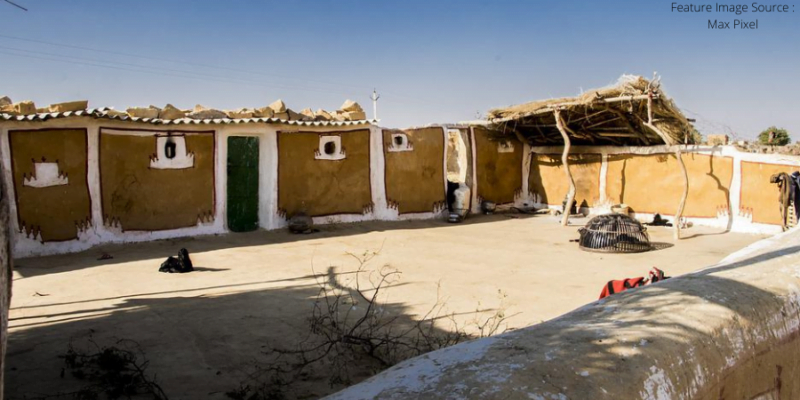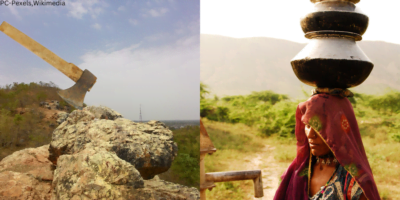Regardless of who we are or where we live or what we do, everyone wants comfort without caring what threats we can pose to the environment with our over-aspiring lifestyle. Future generations are severely impacted by our current decisions and deeds. Making moral decisions that ensure everyone has a safe and livable future is our responsibility.
But are we just bothered? What we eat, drink, shop, use or live in, everything today is depleting mother nature. Just look around you, the four walls you call home, what is it made of- Concrete. Concrete is the second most used material in the world after water. However, its advantages conceal great risks to the environment, human health, and even civilization itself.

The substance is the cornerstone of contemporary civilization, giving billions of people homes over their heads, bolstering our natural disaster defences, and serving as the framework for industries. We try to control nature via concrete. We are shielded from the elements by our slabs. They shield us from the muck, the cold, and the rain. They also safeguard us from becoming wet. But they also enclose huge areas of productive soil, restrict rivers, destroy habitats, and numb us to the world outside our urban castles by functioning as a rock-hard second skin.
And, humanity has been ready to put up with this environmental drawback for hundreds of years in exchange for concrete’s undeniable advantages. But it appears like the scales are shifting now. People have started revisiting their decisions in modern cities and have realized that the alternative to these concrete houses could do magic for society.
Mud is Magic
Mud is the magic to our life that we need. Once you start living in a mud house, there is no coming back.

Being surrounded by earthen walls, with their fresh scent and appealing appearance, is incredibly energizing. Mud house are permeable and naturally cool, and they have been shown to be good for both the environment and humans. Mud house is appropriate for any climate because it is insulating and breathable. In addition, if the mud is sourced locally for the Mud house, it can be reasonably priced, easy to build with, and doesn’t require skilled labour.
Mud house construction is one of the most environmentally friendly building methods since it dries naturally in the sun and does not require the complex manufacturing or firing processes that other materials do.
In addition to this, a mud house contributes a lot to reducing carbon footprint. Some studies place the carbon emissions in cities at around 76 percent, with the housing industry accounting for roughly 30 percent of that total. Mud houses are living, breathing emotional entities. Mud house effectively are good insulators, which reduces energy use.
The advantages of Mud house construction have long been overlooked in favour of mass-produced building materials. Today, however, it is encouraging to witness a resurgence of interest in mud construction among those looking to establish independent houses like Geeli MITTI, An Initiative To Build Sustainable Housing Model
What is Mitti Mane?
It is starling to see how a housing community in Bengaluru – Mitti Mane has made people connect with their roots by experimenting with sustainable practices to transform the space into an eco-sensitive community.
Adjacent to the Bhoomi College campus, it is a community of like-minded people who wanted to build a neighbourhood where their kids can freely play with mud, pluck fruits from trees and eat them and particularly want to live a desi life that causes no harm to the mother nature.
How the idea of sustainable living took a shape of the community?
The urge to be one with nature is the guiding principle of Mitti Mane. This idea came back in the year 2001-2022 when a group of like-minded people gathered in a sustainability workshop organized by the Aastha organization. It is when the initial group of 28 individuals met and decided to procure land of 4 acres in Chikkanayakanahalli, a village on the outskirts of Bengaluru city.

Mitti Mane as of now consists of 15 mud houses each built on a land area of 3000 square feet. As a community thriving to live a basic life full of hardships, it consists of houses made of mud and locally sourced sustainable materials thus reducing the cost of construction by 20-30%. Some houses are fully made of mud blocks and others with a mix of very little use of cement and steel.
These special mud houses incorporate various other energy-saving capabilities like solar panels, solar heaters, rainwater harvesting, greywater treatment, and waste management systems like the reuse of wastewater. Encouraging a healthy lifestyle, this community has over the period attracted a lot many individuals who want to feel protected in the lap of nature.

As a flourishing community built on the principle of togetherness, few guidelines have been imposed that homes to build only using sustainable materials, and one-storey building is allowed all over the space. These practices in the community will keep up the agenda of building Mitti Mane without losing its aesthetics.
With 1 acre of land amidst all the sustainable mud houses, Mitti Mane has kept 1-acre land as a community garden and a forest area for farming. Moreover, there is a plan for the common kitchen community to be implemented in the coming years.
It is so peaceful to see how Bengaluru- A fast-moving city is taking a step ahead and connecting the community with sustainability measures.
Like the different types of soils, people are born in various cultures, communities, and states. What connects us is our mother nature through which we procure all our resources. Let’s protect the “Mitti” that gives us life, rather than stepping forward in modernizing your homes flourish your lives by bringing sustainable colors to your life.
If you loved reading this article, read about Ahmedabad’s Eco-friendly Restaurant That Serves Your Food In Clay Vessels
Feature Image Source: Max Pixel
If you know more inspirational stories about any person, company, new idea, or social initiative, write to us on mad4india.com, or share such information with us on Facebook or LinkedIn.



